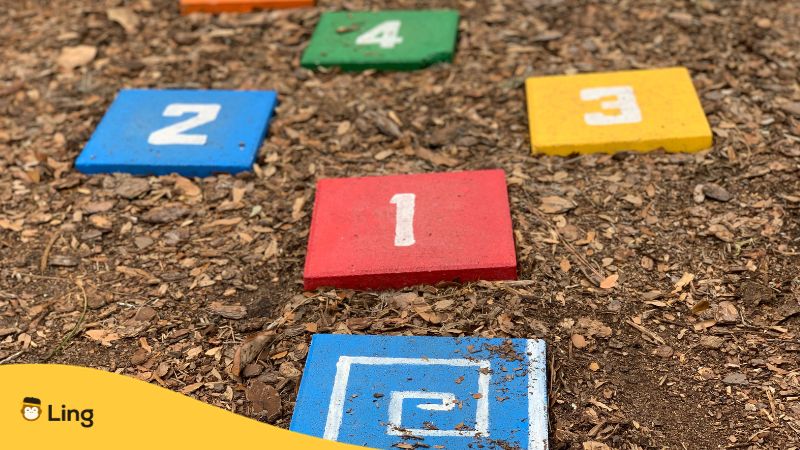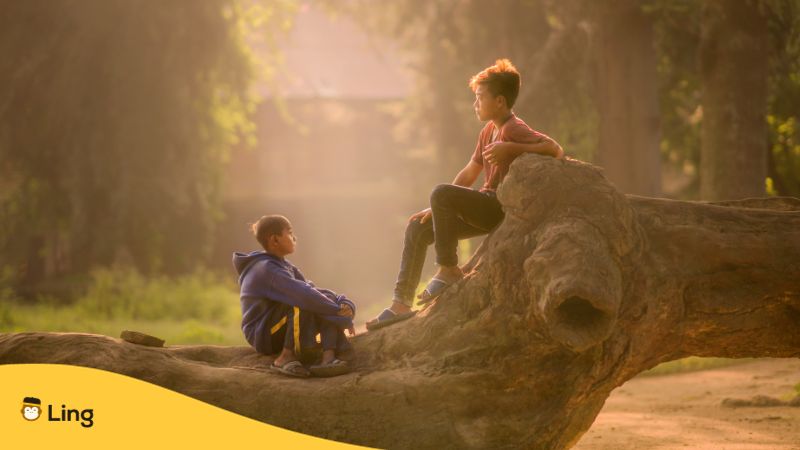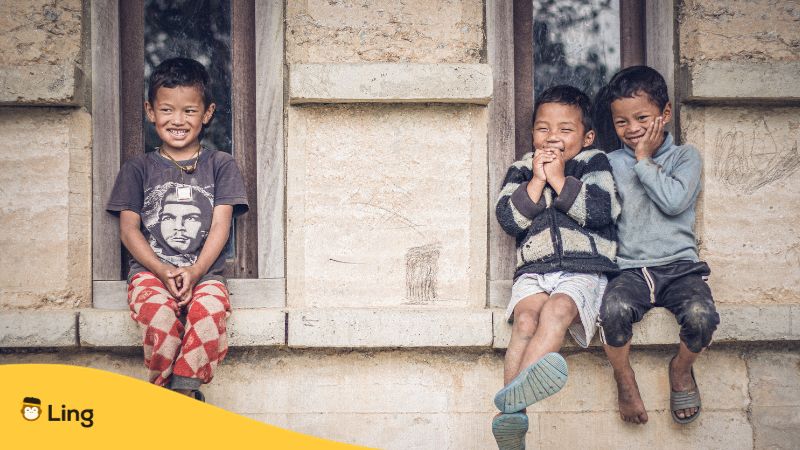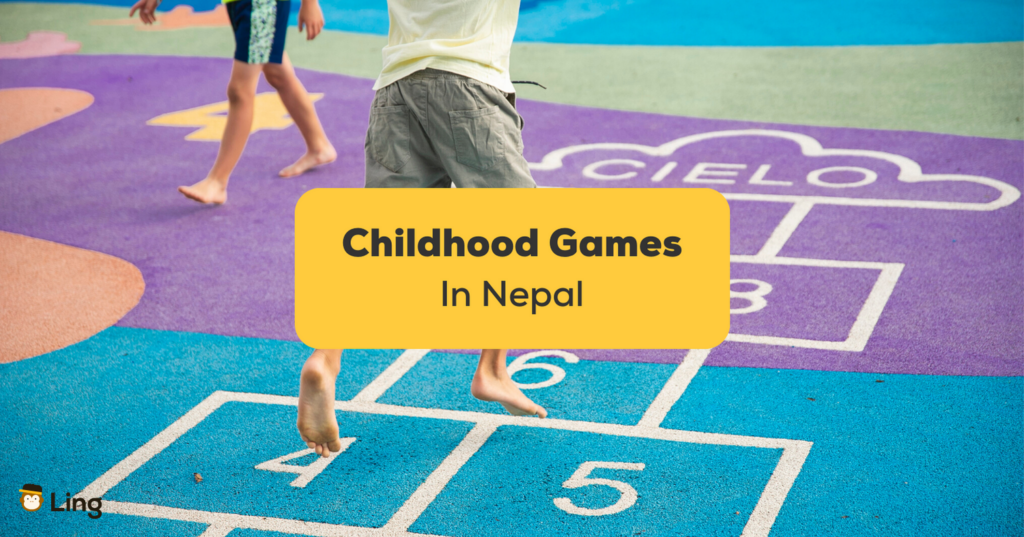Nepal, a country steeped in rich cultural heritage and natural beauty, also boasts a vibrant tradition of childhood games that have been passed down through generations. These games not only entertained children but also taught them valuable life skills important to the culture.
In this article, we’ll take a delightful journey into the world of learning Nepali childhood games, exploring their vocabulary in both Nepali and English. Let’s go!
Fun Nepali Childhood Games
Here is a list of fun Nepali childhood games that might have similar counterparts in other cultures too.
1. Hopscotch – Langdachha
Langdachha (लङ्गडाछ) is a classic Nepali game that requires nothing more than a piece of chalk and a flat surface. Players take turns hopping through a series of numbered squares drawn on the ground. The game enhances balance, coordination, and counting skills.
2. House House Mansion – Saano Ghar
Similar to “Duck Duck Goose,” Saano Ghar (सानो घर) is a popular Nepali version where players sit in a circle. One player walks around the circle while chanting “Saano Ghar, Saano Ghar, Bada Ghar!” (House, House, Mansion). When they say “Bada Ghar,” they tap another player’s head, who then has to chase them around the circle.

3. Similar To Hopscotch – Kut-Kut
While the name might sound similar to Langdachha, Kut-Kut is a distinct game in its own right. It involves drawing a series of square shapes with numbers on the ground. The player tosses a small stone or object into one of the squares, then hops through the squares while avoiding the one with the object.
4. Hide & Seek – Lukamari
Lukamari (लुकामारी) is the Nepali version of the classic hide-and-seek game. One player covers their eyes and counts while others hide. After counting to a certain number, the seeker tries to find the hidden players. The game encourages strategic thinking and spatial awareness.
5. Marbles – Guchcha
Guchcha (गुच्चा) is a competitive game played with small glass or clay balls. Players take turns trying to hit the opponent’s marbles out of a circle drawn on the ground. The winner gets to keep the marbles they’ve collected. This game fosters hand-eye coordination and strategic thinking for kiddos!

6. Tag Pro – Kabbadi
Kabbadi (कबड्डी) is a team game that involves physical contact and strategic planning. One player, known as the “raider,” tries to tag as many opponents as possible while chanting “Kabbadi, Kabbadi.” The opponents aim to evade the raider and tag them in return!
7. Spinning Top – Bunte
Bunte (बुन्ते), also known as the Nepali spin top, is a strategic game that has captivated generations of Nepali people. The game revolves around a small, intricately crafted wooden top and a length of string. Players take turns skillfully spinning the top by wrapping the string around it and then releasing it with a quick flick of the wrist. The objective is to keep the top spinning for as long as possible to score points.
Bunte is more than just a game, it’s a testament to Nepali craftsmanship. Tops are often beautifully adorned with colorful patterns and designs, showcasing the artistry and attention to detail of local artisans. This game not only provides hours of entertainment but also teaches children patience, hand-eye coordination, and the physics of motion.
What’s particularly charming about Bunte is that it transcends generations. It’s not uncommon to see children learning the art of spinning tops from their grandparents, who, in their youth, were masters of the game. This intergenerational connection adds a profound cultural dimension to the experience of playing Bunte, making it a cherished part of Nepali childhood culture!

Childhood Expectations In Nepali Culture
Nepal’s rich cultural heritage and breathtaking landscapes are mirrored in its unique childhood culture. Rooted in respect, responsibility, and resilience, children in Nepal are considered the torchbearers of tradition. Games hold a special place in this cultural tapestry, serving as both entertainment and a vessel for passing down values.
Games As A Way Of Life
Traditional games are integral to Nepali childhood, fostering community, physical fitness, and cultural understanding. They forge lifelong bonds and encourage physical activity, promoting agility and fitness. Moreover, these games convey vital cultural and moral lessons, ensuring the continuation of ancestral traditions in Nepal!
Expectations For Children
Nepali culture places high value on respect for elders, family unity, education, preservation of cultural heritage, and social responsibility. Children are taught to revere their elders, prioritize family welfare, pursue education as a path to upliftment, and actively contribute to their communities. This upbringing ensures that the essence of Nepal’s cultural heritage remains vibrant through generations.

To Conclude
Nepali childhood games offer a delightful window into the cultural heritage of this beautiful Himalayan nation. By exploring these games and their vocabulary, you not only gain insight into Nepali language and culture but also tap into the universal joy of childhood play.
So, gather some friends, find a suitable spot, and immerse yourself in the world of Nepali childhood games! Enjoy the laughter, camaraderie, and the timeless fun that transcends borders and generations, while learning the beautiful language!
Learn Nepali With Ling
Want to learn more Nepali but don’t know where to find resources on this niche language? Download the free Ling app today from the App Store and Play Store.
It is a highly researched language-learning app for a fun and personalized experience. With Ling, you’ll smash your language goals with a little hard work and practice. And if you even more learning resources for Nepali, you can check out useful Nepali verbs & important conversational phrases in Nepali on the Ling blog.
What’s more? Aside from Nepali, there are over 60+ foreign languages to learn on Ling. So, download it today!



































































